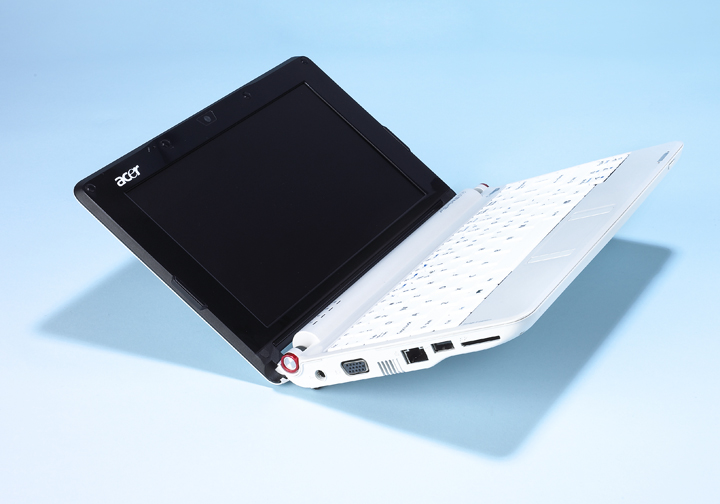Acer Aspire One
With the Asus Eee PC on its third iteration, Acer is hoping to make a splash with its Aspire One.

Take the relatively curt battery life on the chin, and your cash buys you a fantastically capable netbook. We hope that any minor wrinkles will be ironed out by the time production units are available, but for now, the Aspire one wins a well-deserved Recommended award.

Regardless of which model you go for, the Aspire one is fantastically usable. It might be a couple of centimetres wider than any of its Eee branded rivals, but Acer has put that extra space to good use. The keyboard stretches all the way to the edges of the chassis and the keys are taller and slightly wider than those on the Eee; a change which is enough to make longer stretches of typing a far more palatable prospect. The half-height enter key still takes a little getting used to, but where the Eees limit you to short bursts of typing, the Acer is far more capable.
Other elements aren't quite as praiseworthy as, like the HP Mini-note 2133, Acer has shifted the mouse buttons to the left and right hand side of the trackpad. The positioning of the buttons takes some getting used to, but they do at least respond with a crisp click - a clear improvement on the HP Mini-Note's spongy efforts.
The Aspire one's screen more than makes up for the trackpad's shortcomings. At 8.9in from corner to corner and with a native resolution of 1,024 x 600, it effortlessly matches that of Asus' premium 900-series Eee's. Side-by-side with Asus's pricier Eee PC 901, the Acer is just as bright, and only loses out to its rival with its slightly murkier colour reproduction. It's not a big difference, but skintones looked just that touch more lifelike on Asus' Eee.
Peer around the Aspire one's smoothly-contoured sides and connectivity is ample: VGA, Ethernet, USB and an SDHC slot adorn the Acer's left-hand side, while two audio sockets, another couple of USB ports and a 4-in-1 memory card reader lie to the right. The extra SDHC slot is a real boon, though; fill it with a high capacity SD card and you can supplement the basic model's storage quickly and easily. Should you opt for one of the mechanical hard drive options, you can use the SD card as a shock-proof storage medium for your most crucial business data.
If there's one major stumbling block with the Aspire, it's battery life. All the models share the same 2,200mAh battery at their rear and, while sitting idle, our review unit lasted a disappointing two and a half hours, even with the screen set to middling brightness. An extra battery comes as a 68 extra, a supplemental cost that brings the Linux-equipped Aspire one's price dangerously close to that of Asus' Eee PC 901, whose single 6,600mAh battery lasted over eight hours.
Battery life is a huge stumbling block, no doubt there, but where buying a spare battery is easily done, improving the lacklustre keyboard of the Asus Eee, or the poor performance of HP's Mini-Note 2133, is pretty much impossible. And, with that firmly in mind, we find it difficult not to like the Aspire one.
Verdict
Take the relatively curt battery life on the chin, and your cash buys you a fantastically capable netbook. We hope that any minor wrinkles will be ironed out by the time production units are available, but for now, the Aspire one wins a well-deserved Recommended award.
Sign up today and you will receive a free copy of our Future Focus 2025 report - the leading guidance on AI, cybersecurity and other IT challenges as per 700+ senior executives
Processor: 1.6GHz Intel Atom N270 Memory: 512MB RAM Hard disk: 8GB hard disk Graphics, Intel 945GME Express graphics Display: 1,024x600 8.9in TFT Connectivity: VGA, Realtek Audio,3x USB, 802.11b/g, 10/100 Ethernet, 0.3 mega-pixel webcam, SDHC card reader, 4-in-1 card reader OS: Linpus Linux Lite v0.5.15.3 Warranty: 1yr RTB warranty Dimensions(WDH): 249 x 170 x 29mm Weight: 980g
Sasha is a freelance journalist who's been writing about tech and consumer products for over two decades. With a career that started at the dawn of the millennium on Computer Buyer magazine, he passed through the official Intel Centrino magazine, Mobile Computer, before rounding off his print career on PC Pro magazine where he reviewed a broad spectrum of hardware and software before eventually specializing in laptop and monitor reviews. After the best part of a decade, he defected to the desks on the other side of the office and spent many years working on Expert Reviews before finally going freelance in 2024. Nowadays, he splits his time between reviewing tech and home appliances, falling off mountain bikes and cleaning up his kids' playroom.
-
 Trump's AI executive order could leave US in a 'regulatory vacuum'
Trump's AI executive order could leave US in a 'regulatory vacuum'News Citing a "patchwork of 50 different regulatory regimes" and "ideological bias", President Trump wants rules to be set at a federal level
By Emma Woollacott Published
-
 Microsoft Excel is still alive and kicking at 40 – and it's surging in popularity as 82% of finance professionals report ‘emotional attachment’ to the spreadsheet software
Microsoft Excel is still alive and kicking at 40 – and it's surging in popularity as 82% of finance professionals report ‘emotional attachment’ to the spreadsheet softwareNews A recent survey found Gen Z and Millennial finance professionals have a strong “emotional attachment” to Microsoft Excel
By Emma Woollacott Published
-
 LastPass hit with ICO fine after 2022 data breach exposed 1.6 million users – here’s how the incident unfolded
LastPass hit with ICO fine after 2022 data breach exposed 1.6 million users – here’s how the incident unfoldedNews The impact of the LastPass breach was felt by customers as late as December 2024
By Emma Woollacott Published
